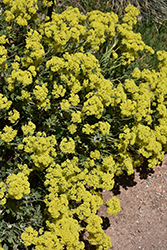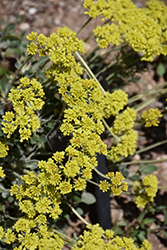It's all about ...
plants

Shasta Sulphur Sulphur Flowered Buckwheat
Eriogonum umbellatum var. polyanthum 'Shasta Sulphur'
Height: 18 inches
Spread: 24 inches
Sunlight:
![]()
![]()
Hardiness Zone: 6a
Other Names: Sulfur Flower Buckwheat, Shasta Buckwheat
Description:
A durable, attractive plant for use in low maintenance landscaping or xeriscaping; intensely yellow, late spring flower clusters mature over summer to orange; the handsome foliage turns burgundy in fall and winter; perfect for rock gardens or naturalizing
Ornamental Features
Shasta Sulphur Sulphur Flowered Buckwheat features showy clusters of yellow flowers rising above the foliage from late spring to late summer. The flowers are excellent for cutting. Its tomentose round leaves are grayish green in colour with curious silver undersides. As an added bonus, the foliage turns a gorgeous burgundy in the fall.
Landscape Attributes
Shasta Sulphur Sulphur Flowered Buckwheat is a dense herbaceous evergreen perennial with a mounded form. Its relatively fine texture sets it apart from other garden plants with less refined foliage.
This is a relatively low maintenance plant, and is best cleaned up in early spring before it resumes active growth for the season. It is a good choice for attracting birds, bees and butterflies to your yard, but is not particularly attractive to deer who tend to leave it alone in favor of tastier treats. It has no significant negative characteristics.
Shasta Sulphur Sulphur Flowered Buckwheat is recommended for the following landscape applications;
- Mass Planting
- Rock/Alpine Gardens
- Border Edging
- General Garden Use
- Groundcover
- Naturalizing And Woodland Gardens
Planting & Growing
Shasta Sulphur Sulphur Flowered Buckwheat will grow to be about 14 inches tall at maturity, with a spread of 24 inches. Its foliage tends to remain dense right to the ground, not requiring facer plants in front. It grows at a medium rate, and under ideal conditions can be expected to live for approximately 10 years. As an evegreen perennial, this plant will typically keep its form and foliage year-round.
This plant does best in full sun to partial shade. It prefers dry to average moisture levels with very well-drained soil, and will often die in standing water. It is considered to be drought-tolerant, and thus makes an ideal choice for a low-water garden or xeriscape application. This plant does not require much in the way of fertilizing once established. It is not particular as to soil pH, but grows best in poor soils. It is highly tolerant of urban pollution and will even thrive in inner city environments. This is a selection of a native North American species.
This plant is not reliably hardy in our region, and certain restrictions may apply; contact the store for more information.

